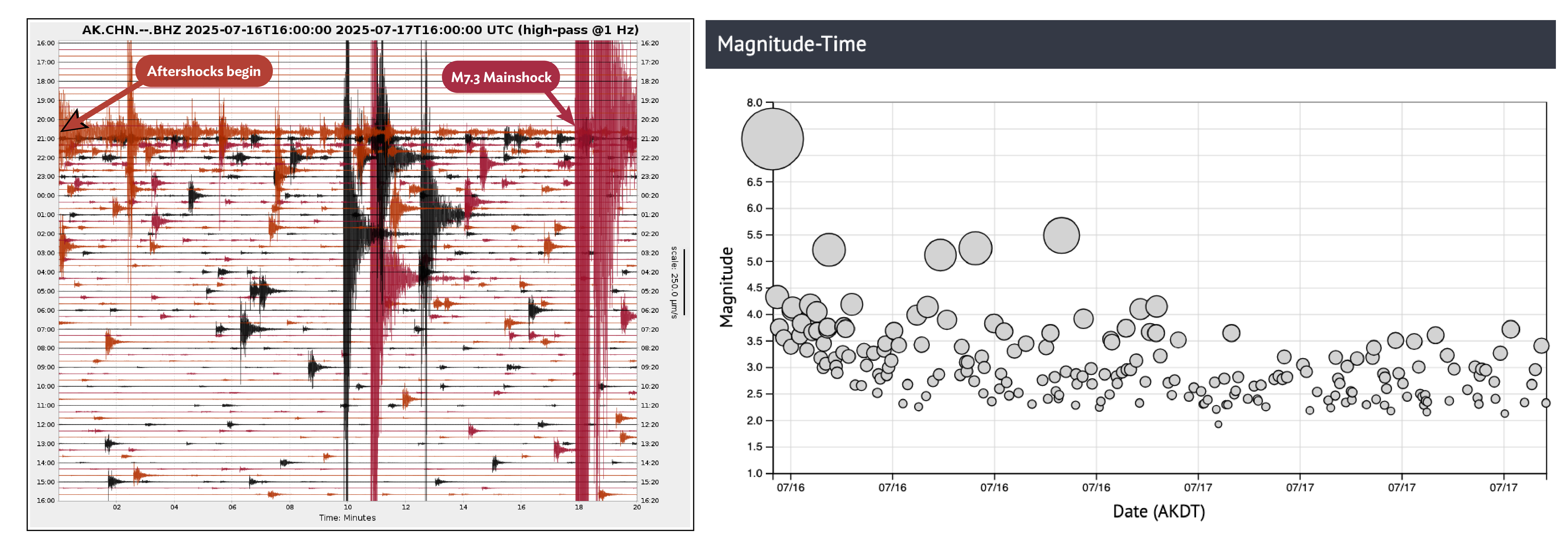2025 M7.3 Sand Point Earthquake
July 18, 2025: Aftershocks continue and are likely to persist in the foreseeable future. The US Geological Survey indicates a small likelihood of a magnitude 7 or greater aftershock, and a high likelihood of aftershocks of magnitude 5 or greater over the next week. There is a very low-likelihood that this earthquake is a foreshock to a larger earthquake, but it remains a possibility.
US Geological Survey aftershock forecast.
 (Left) This seismogram from station CHN shows the “aftershock decay,” or decrease in aftershocks, following the July 16, 2025 M7.3 Sand Point Earthquake mainshock. Each line represents 20 minutes of data recording. At first, the aftershocks appear almost continuous (red line following the mainshock)—in the first 30 minutes, there was an M3+ aftershock roughly every 30 seconds. Gradually the aftershocks become more spread apart on the seismogram, although still only by minutes. Larger aftershocks are sprinkled throughout, with the large spikes of several M5+ aftershocks visible in the middle of the image. Aftershocks can continue for years after a large earthquake. For example, at the time of this M7.3 earthquake, we are still recording aftershocks from the 2020 M7.8 Simeonof Earthquake. (Right) This magnitude-time graph represents the magnitudes of the aftershocks following the July 16, 2025 M7.3 Sand Point Earthquake over time. The four M5+ aftershocks are visible. The smaller aftershocks are initially tightly clustered and overlapping, but start to spread out in time in the hours following the earthquake.
(Left) This seismogram from station CHN shows the “aftershock decay,” or decrease in aftershocks, following the July 16, 2025 M7.3 Sand Point Earthquake mainshock. Each line represents 20 minutes of data recording. At first, the aftershocks appear almost continuous (red line following the mainshock)—in the first 30 minutes, there was an M3+ aftershock roughly every 30 seconds. Gradually the aftershocks become more spread apart on the seismogram, although still only by minutes. Larger aftershocks are sprinkled throughout, with the large spikes of several M5+ aftershocks visible in the middle of the image. Aftershocks can continue for years after a large earthquake. For example, at the time of this M7.3 earthquake, we are still recording aftershocks from the 2020 M7.8 Simeonof Earthquake. (Right) This magnitude-time graph represents the magnitudes of the aftershocks following the July 16, 2025 M7.3 Sand Point Earthquake over time. The four M5+ aftershocks are visible. The smaller aftershocks are initially tightly clustered and overlapping, but start to spread out in time in the hours following the earthquake.
Last Modified: December 14, 2025






